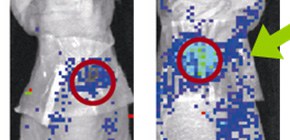
Substance for improving wound healing discovered
Use in stem cell treatments for cutaneous disorders such as atopic dermatitis highly anticipated
A group of researchers led by FUJITA Kosuke (Visiting Researcher) and MAEDA Akito (Specially Appointed Professor) from the HP Skin Regeneration, PIAS Collaborative Research clarified that cinnamtannin B-1, or vegetable-based polyphenol, promotes the migration of Mesenchymal Stem Cells (MSCs) in blood circulation and accumulates them in damaged tissues (Figure 1) to improve wound healing.
It was found that cinnamtannin B-1 was likely to increase its mobility through the activation of enzymes surrounding MSC membranes and that the unique structure of cinnamtannin B-1 played an important role in that mechanism. (Figure 2)
This group clarified that cinnamtannin B-1 accumulated MSC to damaged tissues to improve wound healing. It is anticipated that these results will be used for stem cell treatments for cutaneous disorders associated with various damage and lesions.

Figure 1

Figure 2. Cinnamtannin B-1

Figure 3. Cinnamtannin B-1 enhanced the homing of MSC from the blood circulation to wounds and accelerates wound healing.
Abstract
Substances that enhance the migration of mesenchymal stem cells to damaged sites have the potential to improve the effectiveness of tissue repair. We previously found that ethanol extracts of Mallotus philippinensis bark promoted migration of mesenchymal stem cells and improved wound healing in a mouse model. We also demonstrated that bark extracts contain cinnamtannin B-1, a flavonoid with in vitro migratory activity against mesenchymal stem cells. However, the in vivo effects of cinnamtannin B-1 on the migration of mesenchymal stem cells and underlying mechanism of this action remain unknown. Therefore, we examined the effects of cinnamtannin B-1 on in vivo migration of mesenchymal stem cells and wound healing in mice. In addition, we characterized cinnamtannin B-1-induced migration of mesenchymal stem cells pharmacologically and structurally. The mobilization of endogenous mesenchymal stem cells into the blood circulation was enhanced in cinnamtannin B-1-treated mice as shown by flow cytometric analysis of peripheral blood cells. Whole animal imaging analysis using luciferase-expressing mesenchymal stem cells as a tracer revealed that cinnamtannin B-1 increased the homing of mesenchymal stem cells to wounds and accelerated healing in a diabetic mouse model. Additionally, the cinnamtannin B-1-induced migration of mesenchymal stem cells was pharmacologically susceptible to inhibitors of phosphatidylinositol 3-kinase, phospholipase C, lipoxygenase, and purines. Furthermore, biflavonoids with similar structural features to cinnamtannin B-1 also augmented the migration of mesenchymal stem cells by similar pharmacological mechanisms. These results demonstrate that cinnamtannin B-1 promoted mesenchymal stem cell migration in vivo and improved wound healing in mice. Furthermore, the results reveal that cinnamtannin B-1-induced migration of mesenchymal stem cells may be mediated by specific signaling pathways, and the flavonoid skeleton may be relevant to its effects on mesenchymal stem cell migration.
To learn more about this research, please view the full research report entitled " Cinnamtannin B-1 Promotes Migration of Mesenchymal Stem Cells and Accelerates Wound Healing in Mice " at this page of the PLOS ONE website.
Related links
